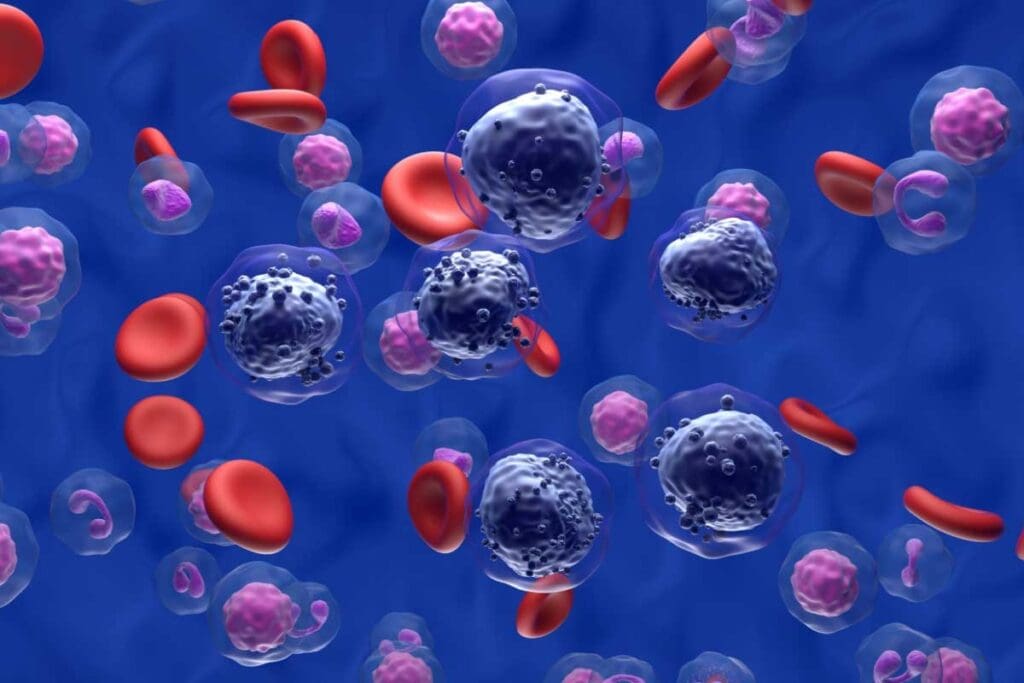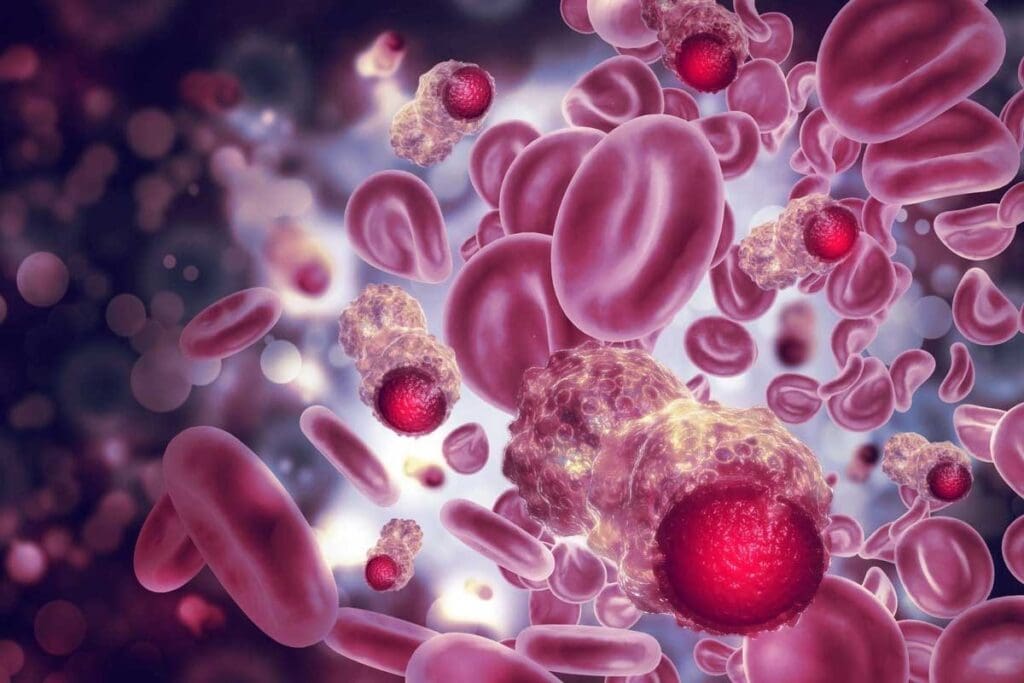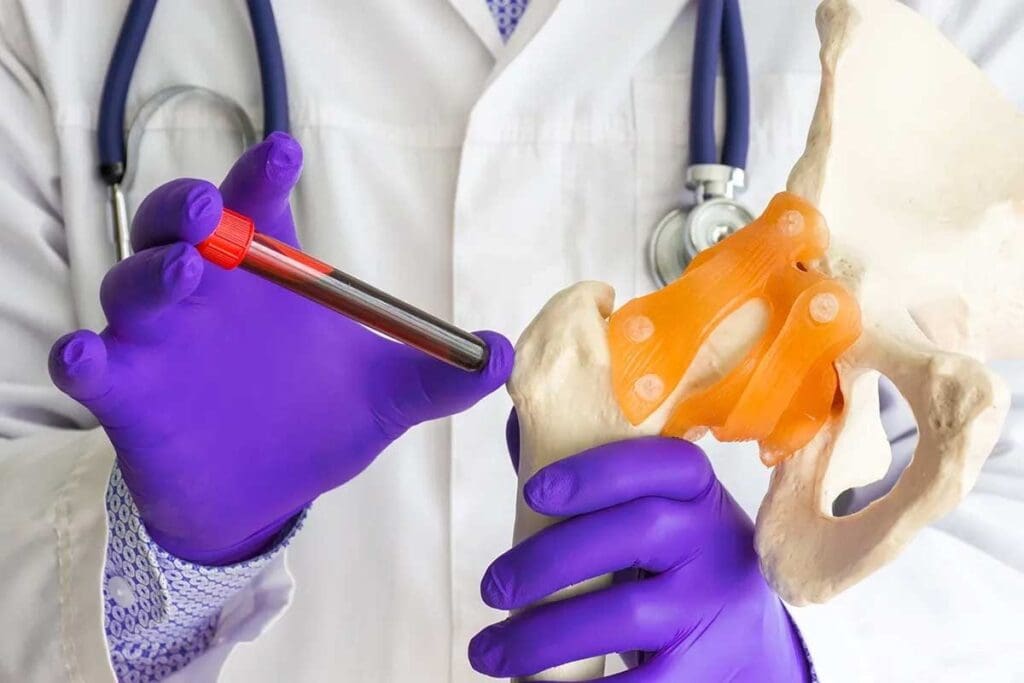Last Updated on November 20, 2025 by Ugurkan Demir

Leukemia is a cancer that affects the body’s blood-making tissues. It happens in the bone marrow, where blood cells are created. When leukemia strikes, it pushes out healthy cells. This means fewer platelets, red blood cells, and white blood cells are made. Learn leukemia and low platelets causes, symptoms, and what it means for patient health management.
This problem makes it hard for the body to clot blood properly. It leads to low platelet counts.
At Liv Hospital, we have a team ready to help those with leukemia. This includes those dealing with low platelet count leukemia. Knowing the causes and symptoms is key to managing the condition well.

Leukemia is a group of blood cancers that affect the body’s blood cells. It’s important to know its types and risk factors for managing the disease.
Leukemia is when abnormal white blood cells grow too much in the bone marrow. This stops normal blood cells from being made. The disease is classified based on the type of blood cell affected and how mature the cells are.
There are four main types of leukemia: Acute Lymphoblastic Leukemia (ALL), Acute Myeloid Leukemia (AML), Chronic Lymphocytic Leukemia (CLL), and Chronic Myeloid Leukemia (CML). Each type affects different people in different ways.
Acute leukemia grows fast and involves immature cells. It gets worse quickly if not treated. Chronic leukemia grows slower and may not show symptoms right away.
Acute leukemia needs quick treatment because it’s aggressive. Chronic leukemia might be watched for a while before starting treatment. Knowing the type of leukemia helps doctors choose the right treatment.
Leukemia is a common cancer worldwide. Risk factors include radiation or chemical exposure, genetic disorders, family history, and smoking. Past cancer treatments can also raise the risk.
Leukemia is not contagious. It can’t be spread from person to person. Blood tests and other procedures help diagnose it and start treatment.

It’s important to know how the bone marrow works to understand leukemia’s effects. The bone marrow makes blood cells, like red and white blood cells, and platelets. This happens through a process called hematopoiesis.
The bone marrow is key for making healthy blood cells. It’s found in bones like the hips and thighbones. It has stem cells that turn into different blood cells.
The bone marrow’s environment helps blood cells grow and mature. It gives them the nutrients and support they need for development.
Hematopoiesis is how stem cells in the bone marrow become blood cells. It has several stages:
This process is controlled by growth factors and other signals. They make sure the right blood cells are made in the right amounts.
Blood cells grow and mature in the bone marrow. Stem cells turn into different types of blood cells. This includes red blood cells, platelets, and white blood cells.
For example, myeloid stem cells can become red blood cells or certain white blood cells. Lymphoid stem cells turn into lymphocytes, like B cells and T cells.
Leukemia harms the bone marrow by filling it with cancer cells. This makes it hard to make healthy blood cells. Knowing how blood cells grow helps us understand leukemia’s effects.
It’s important to understand how leukemia affects platelet production. Leukemia, a blood cancer, harms the bone marrow’s ability to make healthy blood cells, including platelets.
Leukemia cells take over the bone marrow, pushing out healthy cells needed for blood production. This crowd-out disrupts the balance of blood cell creation. The bone marrow is filled with cancer cells, causing a drop in healthy platelet production.
Leukemia cells in the bone marrow reduce space for platelet production and mess with the bone marrow’s function. This mess-up can cause a big drop in platelet count, known as thrombocytopenia. We’ll dive deeper into thrombocytopenia in leukemia patients later.
Many worry if leukemia is contagious. The answer is no; leukemia is not contagious. You can’t catch leukemia from someone who has it. Leukemia comes from genetic changes in bone marrow cells, caused by genes and environment. It’s not spread by touching someone with leukemia.
Platelets, or thrombocytes, are tiny blood cells that help stop bleeding. They are made in the bone marrow and move through the blood. Ready to act, they clump together to form clots and stop bleeding.
Platelets are small, colorless cell fragments key to blood clotting. When a blood vessel gets hurt, platelets stick to the injury. They then release signals that bring more platelets.
This creates a platelet plug that seals the damaged vessel. The coagulation cascade turns this plug into a fibrin clot. This clot stops the bleeding.
A normal platelet count is between 150,000 to 450,000 platelets per microliter of blood. This range might vary slightly between labs but stays roughly the same. Keeping platelet counts in this range is key for proper blood clotting.
In leukemia patients, the platelet count can be greatly affected. The disease can lower platelet production or increase platelet destruction. This leads to low platelet counts, or thrombocytopenia.
A platelet count below 150,000 per microliter is considered low. In leukemia, counts can drop even lower. This raises the risk of bleeding complications.
Understanding how leukemia affects leukemia platelets is vital for managing the disease. Regularly checking platelet counts and taking the right actions can help reduce bleeding risks.
Thrombocytopenia is when you have too few platelets in your blood. It’s common in leukemia patients. It can cause easy bruising, a lot of bleeding, and even serious hemorrhages. Knowing about thrombocytopenia helps manage bleeding risks in leukemia patients.
Thrombocytopenia means having fewer than 150,000 platelets per microliter of blood. It’s found with a simple blood test called a complete blood count (CBC). The CBC counts your platelets to see how bad the thrombocytopenia is.
Key factors in diagnosing thrombocytopenia include:
Thrombocytopenia’s severity depends on the platelet count. Here are the levels:
Knowing the severity helps doctors decide how to treat it.
Leukemia treatment, like chemotherapy and radiation, can hurt platelet production. These treatments can slow down the bone marrow, lowering platelet counts. Sometimes, thrombocytopenia is a side effect of the treatment.
Factors influencing the impact of leukemia treatment on platelet counts include:
Managing thrombocytopenia well is key to reducing bleeding risks and improving leukemia treatment success. By understanding thrombocytopenia’s causes, diagnosis, and severity, doctors can create better treatment plans for patients.
When platelet counts drop, patients may feel a range of symptoms. These symptoms can really affect their life quality. It’s key to spot these signs to manage the condition well.
One common symptom is easy bruising. Even small bumps can cause big bruises because the body can’t clot blood well. Also, cuts or injuries might bleed for a long time, making it hard to stop.
“Bruising easily and bleeding a lot are signs something’s wrong,” a hematologist notes. “It’s important for patients to tell their doctor about these symptoms right away.”
Low platelet counts can cause different skin issues. Petechiae are small spots on the skin from tiny hemorrhages. Purpura are bigger patches of bruising on the body. These show the body can’t keep blood vessels healthy and stop bleeding.
Internal bleeding is a big risk with low platelet counts. Look out for severe headaches, abdominal pain, and vomiting blood. If you see these signs, get help fast.
“Internal bleeding can be very dangerous, so it’s critical to know the warning signs and act fast,” a medical expert stresses.
It’s key to know how leukemia impacts red blood cell production. Leukemia, a blood and bone marrow cancer, messes with blood cell making. This includes red blood cells.
Leukemia can fill the bone marrow with cancer cells. This pushes out the cells that make red blood cells. This results in fewer healthy red blood cells, causing anemia.
Anemia means not enough red blood cells or hemoglobin. This cuts down on oxygen to body tissues. It can make patients feel very tired and weak.
Anemia symptoms in leukemia patients include fatigue, weakness, and pale skin. These happen because tissues don’t get enough oxygen. Oxygen is key for energy and health.
Spotting these signs early is vital for treating anemia.
Dealing with anemia means tackling the leukemia first. Treatments might include blood transfusions to boost red blood cells. Or erythropoiesis-stimulating agents to help make more red blood cells. Also, treating the leukemia itself is important.
We create a treatment plan for each patient. It’s tailored to their needs to better their life quality.
To diagnose leukemia, doctors use several tests. These include blood counts and bone marrow exams. These tests help find blood cell problems and plan treatment.
A complete blood count (CBC) is key in diagnosing leukemia. It checks the levels of blood cells. If these levels are off, it might mean leukemia or another blood issue.
A blood smear analysis is also vital. It looks at blood under a microscope for odd cells. This can spot leukemia cells and other issues.
A bone marrow biopsy takes a small bone marrow sample for study. It checks for leukemia cells in the bone marrow.
Bone marrow aspiration is similar but looks at bone marrow fluid. These tests together give important info on leukemia.
More tests might be needed to confirm leukemia. These include:
These tests, along with a detailed medical check-up, help doctors accurately diagnose leukemia. They then create a good treatment plan.
Our team offers top-notch care for leukemia patients. We focus on treatments for both the cancer and low platelet counts. Effective management often involves a mix of therapies tailored to each patient’s needs.
Chemotherapy is key in treating leukemia, aiming to kill cancer cells. Targeted therapies are more precise, focusing on specific molecules that help cancer cells grow. These treatments aim to manage the disease while protecting healthy cells.
The choice between chemotherapy and targeted therapies depends on the leukemia type, stage, and patient’s health. Our oncologists work closely with patients to find the best treatment plan. They consider side effects and success rates.
Stem cell transplantation is a potentially curative treatment for some leukemias. This involves replacing diseased bone marrow with healthy stem cells. Stem cell transplantation can lead to the regeneration of healthy bone marrow, helping restore normal blood cell production.
For patients with low platelet counts, platelet transfusions are critical. These transfusions help prevent or manage bleeding by increasing platelet counts. Our team also guides on managing side effects and complications, ensuring complete care for our patients.
At Liv Hospital, we are committed to delivering world-class healthcare. We provide full support for international patients. Our team is dedicated to giving the highest level of care, ensuring the best possible outcomes for our patients.
For leukemia patients, managing low blood platelet counts is key to avoid serious bleeding. Low platelet counts, or thrombocytopenia, can come from the disease or its treatment. So, careful management is vital.
Stopping bleeding episodes is a big deal for leukemia patients with low platelets. We suggest a few ways to lower the risk of bleeding:
By following these tips, patients can greatly cut down their chance of bleeding.
Even with precautions, severe bleeding can happen. It’s important for leukemia patients and their caregivers to know what to do in an emergency. Key steps include:
Emergency management may involve platelet transfusions or other interventions to control bleeding and stabilize the patient.
Certain medications can affect platelet function and increase the risk of bleeding in leukemia patients. We need to carefully manage medications that may impact platelet counts or function. Some examples include:
It’s vital for patients to tell their healthcare providers about all medications they’re taking. This helps assess risks and adjust treatment plans.
Getting a leukemia diagnosis means you need a care plan that covers both body and mind. You’ll have to change your daily life a lot. This is to keep you safe and healthy while you’re getting treatment.
People with leukemia must make some lifestyle changes to stay safe. They should avoid sports that could hurt them or cause bleeding. They also need to be careful with things like shaving or cooking.
Safety Precautions: Wearing protective gear and being careful where you are are key. Always have emergency numbers ready in case of an accident.
Eating well is very important for leukemia patients. Good food helps deal with treatment side effects and keeps you healthy.
| Nutritional Element | Benefit | Food Sources |
| Protein | Supports healing and immune function | Lean meats, fish, eggs, dairy |
| Fiber | Aids digestion and prevents constipation | Fruits, vegetables, whole grains |
| Hydration | Essential for overall bodily functions | Water, clear broths, electrolyte-rich beverages |
Living with leukemia is tough for patients and their families. Having access to support, like counseling and support groups, helps a lot. It makes it easier to deal with the disease.
Our team at Liv Hospital is dedicated to providing complete support for international patients. We make sure they get the care and help they need during their treatment.
By choosing wisely, eating well, and using support resources, patients with leukemia can manage their condition better. This improves their life quality a lot.
Leukemia is a complex disease that needs a lot of care and support, mainly for those with low platelet counts. We’ve looked at the causes, symptoms, and treatments for leukemia and low platelets in this article.
Our team is all about top-notch healthcare and support for patients from around the world. We know how important it is to take care of the whole person, not just their disease.
We use the latest treatments and care services to help patients live better lives. This includes medical treatment, making lifestyle changes, eating right, staying hydrated, and helping patients and their families.
At our place, we’re all in on giving leukemia patients with low platelets the care they need. We think a complete approach is key to handling leukemia’s challenges.
Leukemia is a blood cancer that affects the bone marrow. It leads to abnormal blood cell production. This can cause low platelet counts by disrupting normal production in the bone marrow.
No, leukemia is not communicable. It’s a cancer caused by genetic mutations in bone marrow cells. It’s not spread by viruses or bacteria.
Normal platelet counts are between 150,000 to 450,000 per microliter of blood. In leukemia, counts often drop below 50,000. This increases the risk of bleeding.
Thrombocytopenia is low platelet counts. It’s diagnosed with a complete blood count (CBC) test. This test measures the number of platelets in the blood.
Leukemia treatment can lower platelet counts. This is because it suppresses bone marrow function. But, treatments like platelet transfusions can help manage this.
Symptoms include easy bruising, petechiae, and prolonged bleeding. To manage, avoid activities that may cause bleeding. Use protective gear and get platelet transfusions as needed.
Leukemia can disrupt red blood cell production, causing anemia. Symptoms include fatigue, weakness, and shortness of breath. Anemia is managed by treating leukemia and receiving blood transfusions.
Tests include complete blood count (CBC), bone marrow biopsy, and flow cytometry. Genetic testing is also used. These help diagnose leukemia and assess blood cell abnormalities.
Treatments include chemotherapy, targeted therapies, and stem cell transplantation. Supportive care like platelet transfusions is also provided. Liv Hospital offers the latest treatments and care for international patients.
Patients can manage by avoiding activities that cause bleeding. They should also eat well, stay hydrated, and receive supportive care. This includes platelet transfusions and other treatments as needed.
Subscribe to our e-newsletter to stay informed about the latest innovations in the world of health and exclusive offers!